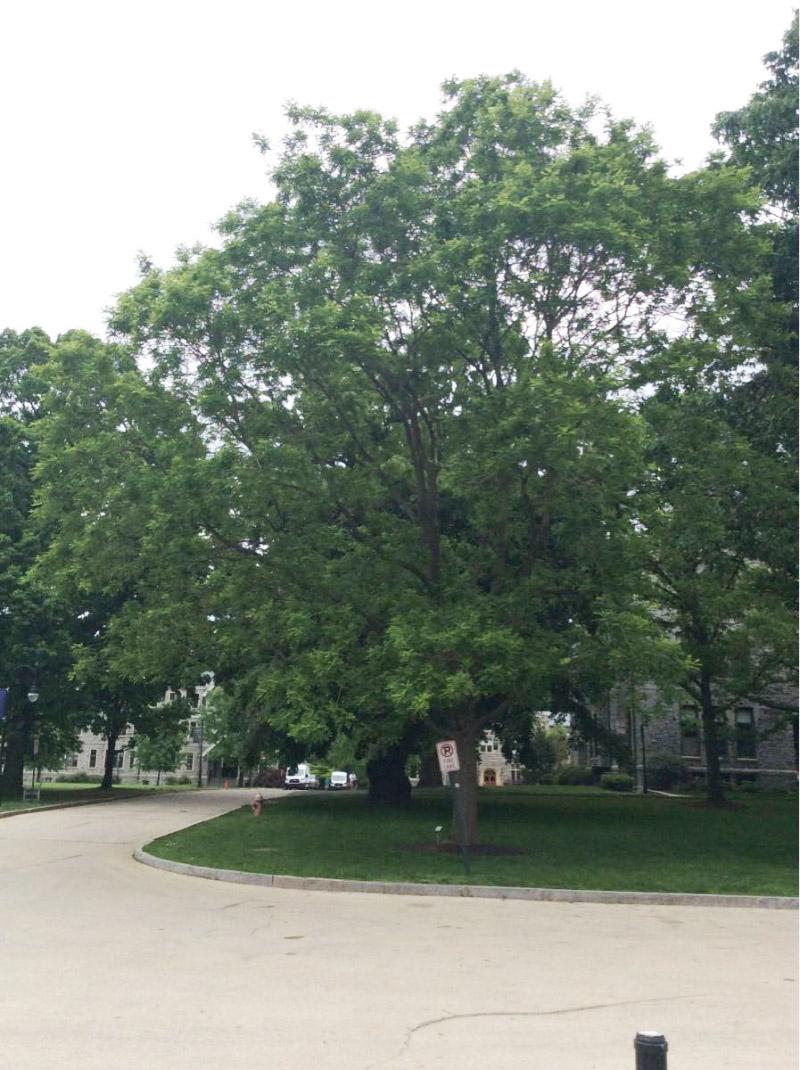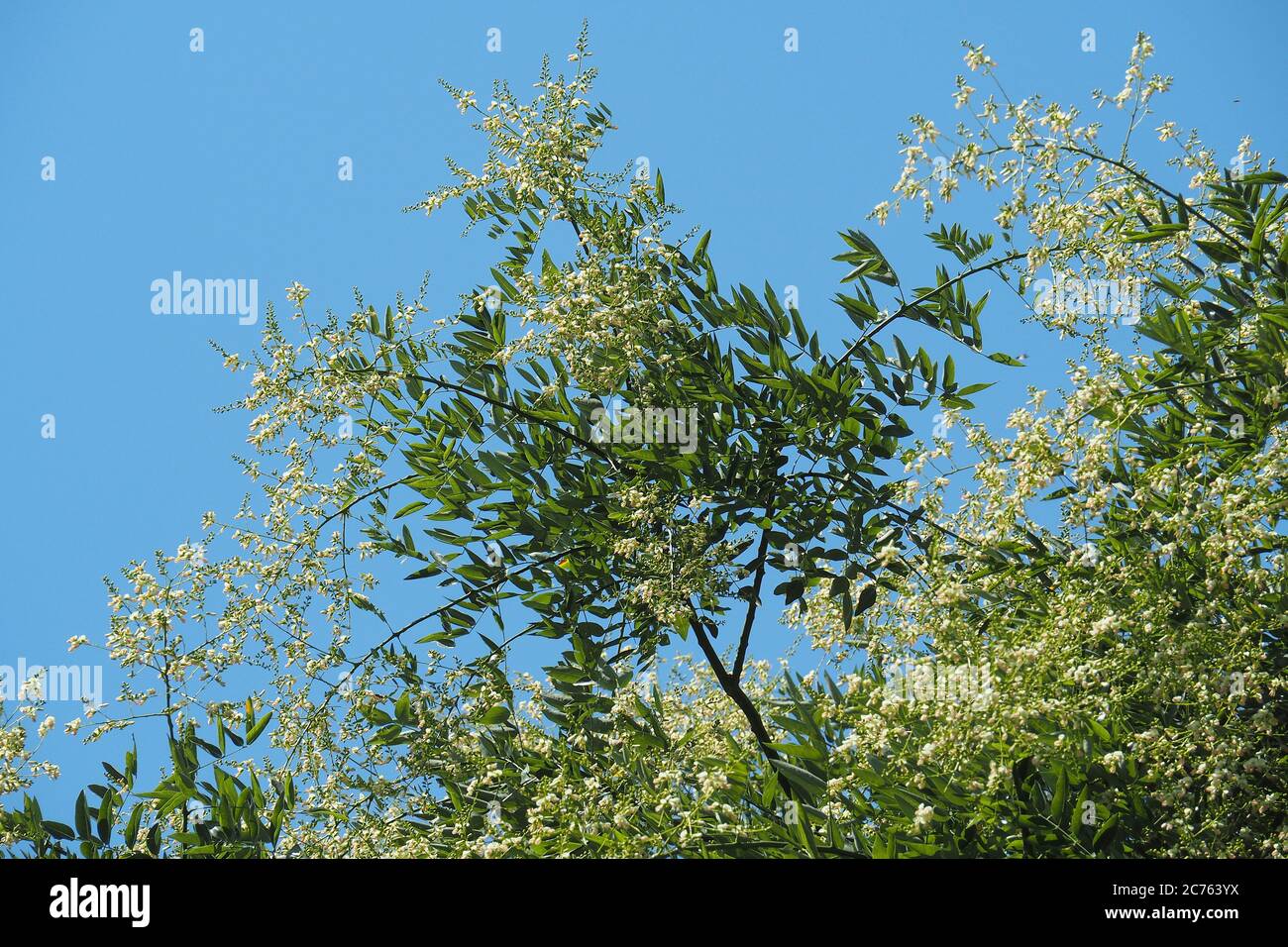japanese pagoda tree invasive
A clusters of creamy white-green fragrant flowers appear in summer. Japanese pagoda tree Styphnolobium japonicum L Schott.
East Experiment Station East side.

. New Invaders of the Southeast. It is a medium to large deciduous tree that typically matures to 50-75 less frequently to 100 tall with a broad rounded crown. Mid-Atlantic Exotic Plant Management Team Invasive Plant List.
It showed exceptional vigor and was drastically different from the. Invasive Species Compendium. NC State Universitys legendary plantsman the late JC Raulston found this wild plant in 1985 while visiting Korea.
Sophora japonica-- Scholar Tree Page 3 Other Figure 3. The Japanese pagoda tree Sophora japonica or Styphnolobium japonicum is a showy little shade tree. The Japanese pagoda tree is often grown as a shade tree in lawns or on patios however flowers and seedpods often leave stains on pavement.
Styphnolobium japonicum L Schott previously. For over two centuries this tree was given the name Sophora japonica. Fruits make very slippery ground when they fall.
As a non-native tree Japanese Zelkova doesnt support native caterpillar species isnt a host for the larvae of pollinating butterflies or moths and doesnt provide food for birds. 2 A recommended goal is to plant. Styphnolobium japonicum commonly called Japanese pagoda tree or Chinese scholar tree is native to China and Korea but not Japan.
The Japanese pagoda tree is originally from China. Its German name Schnurbaum comes from the constricted seed in the seed capsule. The plant is important in traditional medicine and its leaves and flowers are edible.
Under certain environmental conditions some tree species may develop a multi-stemmed or short growth form of less than 13 ft. Since pagoda trees generally stand between 50 and 75 feet this suggests its an old tree but I unfortunately cant find too much history on it. No special winter interest Outstanding tree.
Seedpods of japanese pagoda tree. Despite its name the Japanese pagoda tree is native to China and was introduced to Japan where it is commonly found on the grounds of Buddhist temples. 4 m in height.
Flowers are showy creamy-white on upright panicles up to. Pagoda Dogwood Cornus alternifolia Canker disease is a problem in Eastern NY Witch Hazel Hamamelis virginiana. Ampelopsis brevipedunculata Porcelainberry Invasive Aralia elata Japanese angelica tree Invasive Artemisia vulgaris Mugwort Invasive Arthraxon hispidus var.
The Pagoda tree is highly valued because it blooms very profusely in late summer. How to Grow and Care for the Japanese Pagoda Tree. National Park Service National Capital Region Exotic Plant Management Team Invasive Plant List.
Tree has outstanding ornamental features and could be planted more Invasive potential. The Japanese pagoda tree is often called the Chinese scholar tree. Chinese Scholar Tree also called Japanese Pagoda Tree is one of four species of leguminous trees in this genus and the only one that is cultivated.
This seems more appropriate despite the Japanese reference in its scientific names since the tree. 4 to 5 m in height. There are other pagoda trees.
The Pagoda tree is capable of growing in all soil types although it grows best in well drained loamy soils and in full sun conditions. Japanese pagoda tree Styphnolobium japonicum also called Chinese scholar tree tree of the pea family Fabaceae. Japanese pagoda tree Styphnolobium japonicum Snowbell Styrax japonicus Styrax obassia Tree lilac Syringa reticulata Baldcypress Taxodium distichum Yew.
The Japanese pagoda tree alongside the Boathouse in Brooklyns Prospect Park is an impressive tree with broad boughs. It is generally cultivated for its attractive compound foliage and fragrant. It is by Robert Vidéki at Doronicum Kft.
This plant is an invasive species in North Carolina. 6 through 8A Fig. Honeylocust Gleditsia triacanthos var.
The following species have been reported to be invasive in natural areas. Leguminosae USDA hardiness zones. Princeton Upright Scholar Tree Princeton Upright Japanese Pagoda Tree Family.
One advantage to potting a pagoda plant is the ability to control the reproduction of this plant through rhizomes. According to NYC parks its 861 feet tall. Trees are perennial woody plants with a single stem trunk normally greater than 13 to 16 ft.
Japanese Pagoda Heritage Tree. Sapindus drummondii Western Soapberry An attractive small native tree with glossy compound leaves and excellent deep yellow-gold fall color. See it on the map.
Japanese Pagoda Tree Sophora japonica aka Styphonolobium japonicum Bee Bee Tree Korean Evodia Tetradium daniellii Evodia daniellii is an uncommon landscape tree that is slowly spreading in south-central and southeastern PA Little Leaf Linden Tilia cordata Sterling Silver Linden Tilia tomentosa. Detailed coverage of invasive species threatening livelihoods and the environment worldwide. Optimum conditions for growth.
Hispidus Hairy jointgrass Invasive Arum italicum Italian arum Invasive Arundo donax Giant reed Invasive Bambusa spp. It offers frothy flowers when in season and fascinating and attractive pods. Watch Out for These 20 Invasive and Aggressive Trees.
It is resistant to pests drought and pollution. Japanese Pagoda Japanese pagoda is a large deciduous tree native to China It is an upright forming a lacy canopy of dark green pinnate leaves. While pagoda plants are most commonly planted directly in the ground you can choose to plant them in a pot.
Sophora japonica Where to Look. Surface roots are usually not a problem Winter interest. Trees do best in areas with full sun or partial shade and moderate amounts of water.
Some listed trees are considered to be invasive species and should only be planted in locations where they are not likely to spread into native woodlands. This map identifies those states that list this species on their invasive species list or law. This cultivar of Pagoda Tree has a height of 40 to 50 feet and spread of 30 to 35 feet forming a fine-textured upright rounded canopy even as a young tree.
Japanese Angelica Tree Aralia elata. Staghorn Sumac Rhus typhina Dissecta Cutleaf cultivar will spread Amur Cork Tree Phellodendron amurense. Vulgaris Exotic common bamboo Invasive.
Potting and Repotting. If you do pot the pagoda plant keep in mind its need for fertile well-draining soil. In Japan Europe and North America it has been introduced as a flowering tree.
Seed pods appear in the summertime which can cause serious litter on the ground. Image 5398737 is of Japanese pagoda tree Styphnolobium japonicum damage. It is hardy to -25F 317C.
How to Choose the Right Ginkgo Biloba Tree. Foliage of Scholar Tree. Little if any potential at this time Ozone sensitivity.
Arbre des pagodes du Japon. It was growing in front of a private school and appropriately enough was a Chinese Scholar Tree Styphnolobium japonicum.

Japanese Pagoda Tree Styphnolobium Japonicum Bryn Mawr College

Japanese Pagoda Tree Styphnolobium Japonicum Fabales Fabaceae Leguminosae 5539402

Japanese Pagoda Tree Chinese Scholar Tree

Japanese Pagoda Tree Deciduous 15m 20m High Seed Pods Japanese Pagoda Amazing Gardens Tree

Japanese Pagoda Tree Styphnolobium Japonicum Fabales Fabaceae Leguminosae 5396099

Japanese Pagoda Tree News From Rockcliff Farm

Japanese Pagoda Tree Japanischer Schnurbaum Styphnolobium Japonicum Sophora Japonica Kozonseges Pagodafa Japanakac Hungary Magyarorszag Europe Stock Photo Alamy

Japanese Pagoda Tree News From Rockcliff Farm

A Japanese Pagoda Tree Sophora Japonica L Planted In A Roadside Download Scientific Diagram

Sophora Japonica Pendula Trees Marcopolo Plants Shade Trees Fast Growing Shade Trees Garden Trees
Japanese Pagoda Tree Becoming Popular In U S Cities What Grows There Hugh Conlon Horticulturalist Professor Lecturer And Gardener
Japanese Pagoda Tree Becoming Popular In U S Cities What Grows There Hugh Conlon Horticulturalist Professor Lecturer And Gardener

Japanese Pagoda Tree Japanischer Schnurbaum Styphnolobium Japonicum Sophora Japonica Kozonseges Pagodafa Japanakac Stock Photo Alamy

Japanese Pagoda Tree Styphnolobium Japonicum Fabales Fabaceae Leguminosae 5539406

Weeping Pagoda Tree Sophora Japonica Pendula Up To 5m A Picturesque Grafted Weeping Tree With A Gnarled Trunk And Witch Garden Weeping Trees Nature Photos

Styphnolobium Japonicum Or Japanese Pagoda Tree Is A Popular Ornamental Tree In Europe North America And South Africa Stock Photo Download Image Now Istock

Japanese Pagoda Tree Styphnolobium Japonicum Fabales Fabaceae Leguminosae 5539401


